
Korean cuisine has evolved through centuries of social and political change. Originating from ancient agricultural and nomadic traditions in Korea and southern Manchuria, Korean cuisine reflects a complex interaction of the natural environment and different cultural trends.

The horseshoe is an open-faced sandwich originating in Springfield, Illinois, United States. It consists of thick-sliced toasted bread, a hamburger patty or other choice of meat, French fries, and cheese sauce.

Service à la française is the practice of serving various dishes of meal at the same time, with the diners helping themselves from the serving dishes. That contrasts to service à la russe in which dishes are brought to the table sequentially and served individually, portioned by servants.

A buffet can be either a sideboard or a system of serving meals in which food is placed in a public area where the diners serve themselves. A form of service à la française, buffets are offered at various places including hotels, restaurants, and many social events. Buffet restaurants normally offer all-you-can-eat food for a set price, but some measure prices by weight or by number of dishes. Buffets usually have some or mostly hot dishes, so the term cold buffet has been developed to describe formats lacking hot food. Hot or cold buffets usually involve dishware and utensils, but a finger buffet is an array of foods that are designed to be small and easily consumed only by hand, such as cupcakes, slices of pizza, foods on cocktail sticks, etc.

Tableware is any dish or dishware used for setting a table, serving food, and dining. It includes cutlery, glassware, serving dishes, and other items for practical as well as decorative purposes. The quality, nature, variety and number of objects varies according to culture, religion, number of diners, cuisine and occasion. For example, Middle Eastern, Indian or Polynesian food culture and cuisine sometimes limits tableware to serving dishes, using bread or leaves as individual plates, and not infrequently without use of cutlery. Special occasions are usually reflected in higher quality tableware.
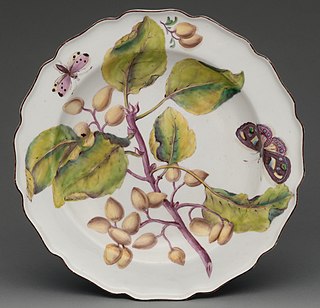
A plate is a broad, mainly flat vessel on which food can be served. A plate can also be used for ceremonial or decorative purposes. Most plates are circular, but they may be any shape, or made of any water-resistant material. Generally plates are raised round the edges, either by a curving up, or a wider lip or raised portion. Vessels with no lip, especially if they have a more rounded profile, are likely to be considered as bowls or dishes, as are very large vessels with a plate shape. Plates are dishware, and tableware. Plates in wood, pottery and metal go back into antiquity in many cultures.

A salt cellar is an article of tableware for holding and dispensing salt. In British English, the term is normally used for what in North American English are called salt shakers. Salt cellars can be either lidded or open, and are found in a wide range of sizes, from large shared vessels to small individual dishes. Styles range from simple to ornate or whimsical, using materials including glass and ceramic, metals, ivory and wood, and plastic.
African cuisine is a staple of the continent's culture, and its history is entwined with the story of the people of Africa. The foods that Africans eat have been influenced by their religions, as well as by their climates and lifestyles. The first Africans to inhabit the continent were hunter-gatherers who ate what they could find in nature. As agriculture became more common in Africa, so did agriculture-based diets.
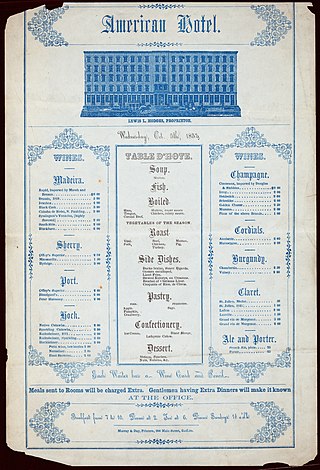
In restaurant terminology, a table d'hôte menu is a menu where multi-course meals with only a few choices are charged at a fixed total price. Such a menu may be called prix fixe. The terms set meal and set menu are also used. The cutlery on the table may also already be set for all of the courses.

Arab cuisine is the cuisine of the Arabs, defined as the various regional cuisines spanning the Arab world, from the Maghreb to the Fertile Crescent and the Arabian Peninsula. These cuisines are centuries old and reflect the culture of trading in baharat (spices), herbs, and foods. The regions have many similarities, but also unique traditions. They have also been influenced by climate, cultivation, and mutual commerce.
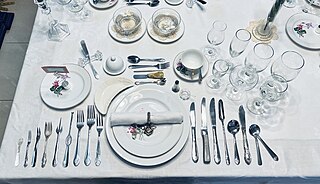
A full-course dinner is a dinner consisting of multiple dishes, or courses. In its simplest form, it can consist of three or four courses; for example: a starter, a main course, and dessert.

Leftovers are surplus foods remaining unconsumed at the end of a meal, which may be put in containers with the intention of eating later. Inedible remains like bones are considered waste, not leftovers. Depending on the situation, the amount of food, and the type of food, leftovers may be saved or thrown away.

Table manners are the rules of etiquette used while eating, which may also include the use of utensils. Different cultures observe different rules for table manners. Each family or group sets its own standards for how strictly these rules are to be followed.
The historical form of service à la russe is a manner of dining with courses brought to the table sequentially, and the food portioned on individual plates by the waiter. It contrasts with the older service à la française based on several courses brought to the table simultaneously, in an impressive display of tureens and serving dishes, with diners plating food themselves.
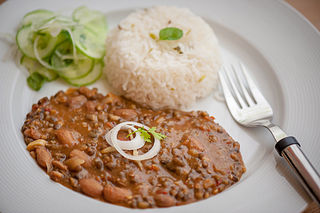
Dal makhani is a dish originating in Punjab, India. A relatively modern variation of traditional lentil dishes, it is made with urad dal and other pulses, and includes butter and cream.

Customs and etiquette in Chinese dining are the traditional behaviors observed while eating in Greater China. Traditional Han customs have spread throughout East Asia to varying degrees, with some regions sharing a few aspects of formal dining, which has ranged from guest seating to paying the bill.

A steak is a thick cut of meat generally sliced across the muscle fibers, sometimes including a bone. It is normally grilled or fried. Steak can be diced, cooked in sauce, such as in steak and kidney pie, or minced and formed into patties, such as hamburgers.

The bone marrow of animals is widely used by humans as food. It consists of yellow marrow contained in long bones. There is also red marrow, which contains more nutrients than yellow marrow. It may be found in bone-in cuts of meat purchased from a butcher or supermarket.
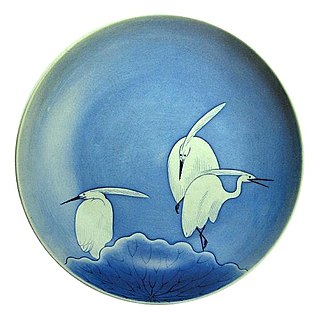
Nabeshima ware is a type of Japanese pottery, specifically an unusually high-quality porcelain Arita ware. It was produced in Lord Nabeshima of Saga Domain's kiln at Okawachi near Arita in the Edo period, for the use and profit of the family. The name therefore derives from the family. The Okawachi kiln was already in use, and continued to make other wares at the same time. Production began around 1700, and continued until the late 19th century, with similar wares being produced elsewhere by descendants of the master lineage to the present day

Veal Milanese, or veal alla Milanese, is an Italian dish in Milanese Lombard cuisine, and a popular variety of cotoletta. It is traditionally prepared with a veal rib chop or sirloin bone-in and made into a breaded cutlet, fried in butter. Due to its shape, it is often called oreggia d'elefant in Milanese or orecchia d'elefante in Italian, meaning elephant's ear.


















